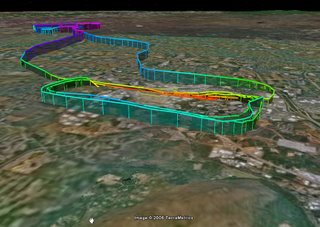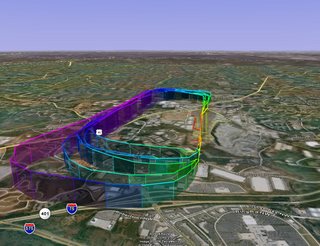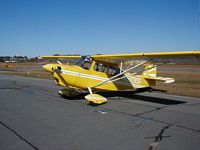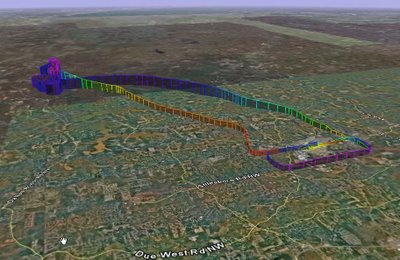
There was a time when the third wheel was located on the back of the airplane. When they started putting it up front it was considered unconventional, tricycle gear. Since it was so much easier to control the airplane on the ground (including take-offs and landings) the tricycle configuration became standard and conventional gear went the way of the manual transmission. So, like sports cars, conventional gear is found on really fun airplanes.
My preparation for this transition included two books:
Conventional Gear, Flying a Taildragger by David Robson, and
The Complete Taildragger Pilot by Harvey S. Plourde. I think Harvey's book is superior by providing more analysis of the aerodynamics, especially what causes the 'jounce'. I also studied the Pilots Operating Handbook for the Decathlon and took the written test required by the Flying Club.
The weather was iffy. Ernesto had just passed through to the east of us and some of its remnants were stirring up the air. Bases were anywhere from 1200 broken to 1700 overcast, and nearby Dobbins AFB (KMGE) was reporting variable ceiling height (CIG). No showers and an occasional hole with blue sky peeking through kept me optimistic during my short drive to the airport. Due to some scheduling changes, my flight had fortunately been pushed back to noon, and when I arrived my instructor was still out on another (instrument training) flight.
Objectives of this flight: Introduction to conventional flying.
My log book says my last flight in a taildragger was 1.5 hours solo in an Aeronca 7Ac up in Slatington (69N) during the fall of 1970. My instructor at that time had limited me to full stall (3 point) landings, and I don't remember the limits on crosswind component. FAR 61.31 (i) (2) says that I'm grand-fathered in for my tailwheel endorsement, but 36 years seems to be just a bit long between flights for me to be safe. I wasn't sure that this was 'like riding a bicycle', so I scheduled plenty of time to get checked out. Note: the Decathlon is a fully aerobatic aircraft. However I didn't think it wise to put my already overloaded frame though 3.5 g pull ups. Just too many pounds and too many years since I did that the last time. I'll forego the aerobatics for now.
My instructor arrived and we introduced ourselves, talked about experiences, etc, and what I wanted to get out of this training. I mentioned spin training, soft field operations and just getting back to basics. Preflight and ground ops were straight forward. This airplane has a constant speed prop (which I haven't played with before) but otherwise the cockpit is pretty basic. Taxiing is not unlike the Tiger, just a bit slower and the need to anticipate corrections sooner. I got through the runup with a few embarrassments, but overall not too bad.
Ah the takeoff. All of the studying told me what would happen. My mental rehearsals warned me what might happen. Even so, the darn airplane went heading for the weeds on the left of side of the runway as soon as I lifted the tail. (Torque, P-factor, winds...Whatever, the airplane goes left and pushing the rudder full right is NOT the correct response.) Just plain ugly.
Once airborne (thankfully) we headed north to a practice area over the lake. Unfortunately the clouds were too low to allow any stalls. So I just got familiar with the controls, slow flight, etc. Sitting on the aircraft centerline and flying a stick instead of a yoke...Is FUN! I'm falling in love again.
Well, let's go try some landings. First, where is the airport? No GPS, low clouds, can't see Mt Kennesaw, where the heck am I? My instructor pointed out the bridge that marks about 9.5 miles northwest of the field and slowly I got my bearings. ATIS remained the same and I was cleared for a right downwind. My spacing was good, speed was good, altitude a little sloppy (-200), but I was comfortable. Nice line up on final, good rate of descent to my spot, everything was good. I got into my flare a bit high, held it off and...'jounce'. The third landing was pretty good. (I could only log one of them though.) We took the next taxiway and went back for more.
OK, so what is the 'jounce'? When you land a tricycle gear plane, the mains touch and you lower the nose. The angle of attack (AOA) is reduced, reducing lift. In a taildragger, after the mains touch you lower the tail, increasing the AOA and therefore the lift and up you go...jounce.
The next iterations were similar, showing some slight improvement. Lets just say that I'm getting the picture but it is not yet fully developed. So, was this a successful flight? This is FUN stuff! Humility is good for the soul, so that part of me is very healthy right now, and I still have a smile on my face.
We went 73.3 miles, climbed to 2647 feet and reached 135 mph over the ground.
8KCAB
Time = 1.3
* Note: Olathe did a great job with the 96c. Overnight air got it back quickly and I'm happy with the results.
 The weather was spectacular. The seasons have changed here and morning temps have been cool in the low 50's. The visibility was a little less today, but still better then 10 miles.
The weather was spectacular. The seasons have changed here and morning temps have been cool in the low 50's. The visibility was a little less today, but still better then 10 miles.



